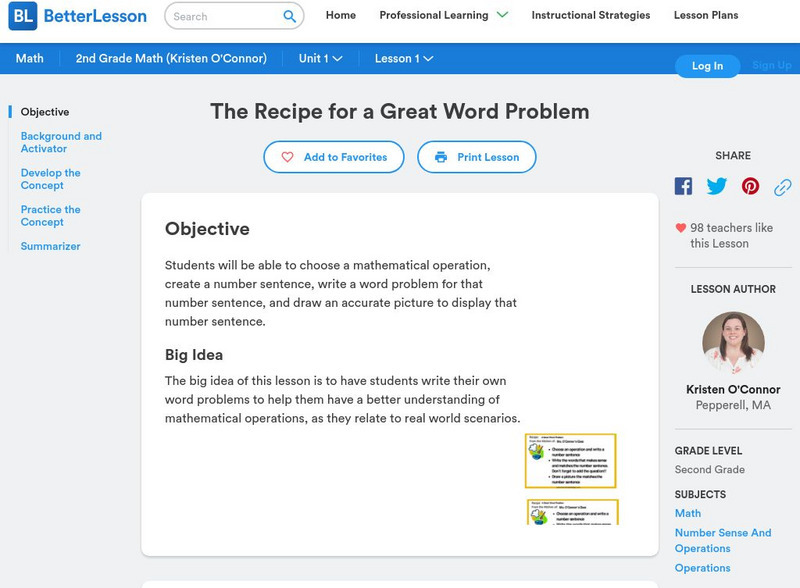Better Lesson
Better Lesson: Using Models to Add and Subtract
Common Core standards encourage the use of models to build understanding in math. This lesson shows sometimes reluctant 2nd graders that models are helpful tools in solving mathematical problems.
Alabama Learning Exchange
Alex: My Favorite Number
The activity allows students to review many of the number theory concepts. Students will pick a composite number write verbal expressions about the number, find the factors, prime factorization, list multiples, draw a cartoon character...
Better Lesson
Better Lesson: Towers, Towers, Towers 1 5
Children develop a true sense of number by working with real things. In this lesson, kindergarteners use blocks to build towers, learning what numbers 1-5 mean.
Better Lesson
Better Lesson: Towers, Towers, Towers 6 10
This lesson plan is the sequel to Towers! Towers! Towers! 1-5. Students continue to develop their sense of quantity as they build successive taller towers.
Better Lesson
Better Lesson: How Are They Different?
SWBAT order a set of numbers and quantities up to 12 and compare two quantities up to 10 to see which one is greater. The students will also demonstrate their knowledge of how the numbers in the counting sequence are related (that each...
Better Lesson
Better Lesson: Writing Equations for Arrays
Second graders will learn how to make number sentences for an array by walking around the classroom and writing number sentences for the different arrays the teacher hangs around the room. A video is included, along with examples of...
Better Lesson
Better Lesson: Understanding Tape Diagrams
Using a tape diagram is one of the key models for ratios and proportions.
Better Lesson
Better Lesson: Assessment Day
SWBAT use strategies to identify rational numbers on a number line.
Better Lesson
Better Lesson: What Is Today?
SWBAT identify the name of the month, number of the day, and number of the year on a calendar. SWBAT explore math tools, and will demonstrate their ability to count 20 objects.
Better Lesson
Better Lesson: Spatial Patterns for Numbers 10 Through 15
SWBAT use a ten frame to build and identify the numbers 10 through 15.
Better Lesson
Better Lesson: Spatial Patterns for 0 5
SWBAT match dot patterns and ten frame patterns to their appropriate number.
Better Lesson
Better Lesson: Patterns for Numerals 6 10
SWBAT count to ten and identify numbers by counting object patterns.
Better Lesson
Better Lesson: How Many in Your Box?
SWBAT make a connection between number names and written numbers to the quantities they represent. They will also practice ordering numbers and quantities up to 12. Students will also document a solution to a problem
Better Lesson
Better Lesson: Building Towers
SWBAT count a set of up to 20 objects by 1's. SWBAT use number names and written numbers to label the quantities they represent. SWBAT order a set of numbers and quantities up to 12.
Better Lesson
Better Lesson: Start At/stop At
SWBAT practice the rote counting sequence both forwards and backwards, from 1-30. SWBAT use a number line as a tool for counting. SWBAT count sets of objects up to 20.
Better Lesson
Better Lesson: Building Tens at the Lego Factory
SWBAT create a number using groups of tens and extra ones.
Better Lesson
Better Lesson: It's Elementary My Dear Watson
SWBAT identify and build numbers based on base ten language.
Better Lesson
Better Lesson: Match Me!
Kids love to count and build puzzles. This activity encourages them to do both! The kids count objects on puzzle pieces and match the groups of objects to the correct number.
Better Lesson
Better Lesson: Greater or Less?
Students will determine within number sets which digit is "greater" or "less"
Better Lesson
Better Lesson: Tubing Tens Cool Off With an Imaginary River Adventure
If you know how to count by tens, you can solve multiplication problems in which ten is a factor.
Better Lesson
Better Lesson: Greatest Common Factor
Sixth graders will learn how to find the Greatest Common Factor of two or more numbers by using math manipulatives.
Better Lesson
Better Lesson: The Recipe for a Great Word Problem
The big idea of this lesson plan is to have students write their own word problems to help them have a better understanding of mathematical operations, as they relate to real-world scenarios. Pictures and videos of the lesson plan in the...
Illustrative Mathematics
Illustrative Mathematics: Egyptian Fractions
One goal of this task is to help students develop comfort and ease with adding fractions with unlike denominators. Another goal is to help them develop fraction number sense by having students decompose fractions. Aligns with 5.NF.A.1.
Better Lesson
Better Lesson: Skittle Arrays
Skittles - yum!! You will instantly have your student's attention when you teach about arrays using Skittles. This detailed lesson walks you through the steps, provides worksheets for varying math levels, and includes a video of the...




